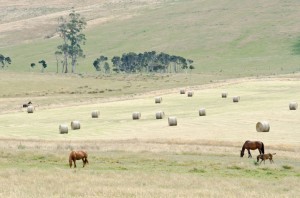Extent Of Parasite Resistance
How Common is Worm Resistance?
Resistance to anthelmintic drugs is a concern worldwide.
Resistance in Horse Parasites
 The main problem in horses is resistance in the small strongyles (see Table 1), although few studies have been conducted in Australia. How common resistance is varies depending on the class of drug.
The main problem in horses is resistance in the small strongyles (see Table 1), although few studies have been conducted in Australia. How common resistance is varies depending on the class of drug.
There are 3 main classes of anthelmintic drugs used in horses: the benzimidazoles (BZ; e.g. fenbendazole, oxfendazole and oxibendazole), the tetrahydropyrimidines (THP; e.g. morantel and pyrantel) and the macrocyclic lactones (ML; e.g. abamectin, ivermectin and moxidectin). Praziquantel used for treatment of tapeworms belongs to an additional class. There is widespread prevalence of resistance in the small strongyles to BZ.
Table 1. Current levels of resistance in major nematode parasites to the 3 major anthelmintic drug classes in managed horse herds
| Drug class | Small strongyles | Large strongyles | Ascarids |
|---|---|---|---|
| BZ | Widespread | None | None |
| THP | Mainly in the USA * | None | Early indications |
| ML | Early indications | None | Possibly quite widespread |
* where pyrantel resistance has been commonly observed (one Australian study found resistance to morantel on a couple of properties)
So far, the ML group has maintained its effectiveness against the small strongyles, although there have been some recent reports of resistance, and also reports of an earlier reappearance of eggs after treatment, suggestive of early resistance. With widespread usage, many parasitologists are anticipating the development of ML resistance, especially as it is common in closely related worms in sheep and goats.
Resistance in Parasites of Sheep, Cattle, Goats and Alpacas
Sheep, Goats and Alpacas
There are 4 main classes of anthelmintic drugs used in sheep: the benzimidazoles (BZ; e.g. albendazole, oxfendazole and fenbendazole; ‘white drench’), levamisole (LEV;’clear drench’), the macrocyclic lactones (ML; e.g. abamectin, ivermectin, moxidectin, doramectin and eprinomectin), and aminoacetonitrile derivatives (monepantel; ‘orange drench’). Derquantel of the spiroindole class has been recently released in Australia and marketed in combination with abamectin.
Resistance in sheep and goat worms to most anthelmintics of the 4 main classes is now fairly common in Australia. Resistance (<95% drug effectiveness) to BZ drenches and LEV drenches is widespread (about 90% and 80% of Australian properties, respectively), while about 60% of properties have worms resistant to combination BZ and LEV drenches. Resistance to ML drenches is becoming more common, with 10-70% of Australian properties, depending on region, affected. Resistance in Teladorsagia spp. is very common in WA and in Haemonchus contortus is very common in northern NSW/south eastern Queensland. Resistance to closantel in Haemonchus contortus is also common (60-80% of properties) in northern NSW/south eastern Queensland.
Drench resistance is also an increasing problem on alpaca properties in Australia. A case of ML resistance of Haemonchus contortusCattle
There are 3 main classes of anthelmintic drugs used in cattle: the benzimidazoles (BZ; ‘white drench’), levamisole (LEV;’clear drench’) and the macrocyclic lactones (ML).
While anthelmintic resistance in nematodes is not as a big a problem in cattle as in sheep and goats, it is no longer uncommon and is likely to become an increasingly important problem. In some countries, the prevalence of resistance is high, most notably in New Zealand where over 90% of farms surveyed in 2005 contained resistant parasites. There are also indications that resistance might be common in parts of Argentina, Brazil and Europe. Most reported cases of resistance worldwide have involved Cooperia spp. (generally considered to be less pathogenic than other worm species infecting cattle). However, resistance to the BZ class appears to involve all the major species infecting cattle, which could reflect the extended period of use since their introduction in the 1960s. ML resistance in Haemonchus spp. has been reported on numerous occasions from South America. Results of a study of resistance in cattle nematodes in Victoria have revealed a substantial prevalence of resistance in Ostertagia ostertagi to ivermectin (of the ML class) and LEV, as well as BZ.
All Species
Resistance to one member of a class generally means there is resistance to all members of the class. Thus, if you find that worms on your property are resistant to a particular drug, you should not use that drug or any other drugs in that class as a single treatment on your property again. You will not need to repeat a FECRT for that class.
Multidrug resistance to more than one drug class, and particularly to all drug classes available for a specific species, is a concern.
Particularly in the case of sheep and goats, as the level of parasite drug resistance increases, drenches are not the easy solution they once were. New drugs, and particularly of a new drug class, are not developed rapidly by the pharmaceutical industry. Thus, when designing parasite control programs, it has become very important to attempt to minimise the development of resistance to existing drug products, and thereby maintain the effectiveness of these drug products on your property for as long as possible.
